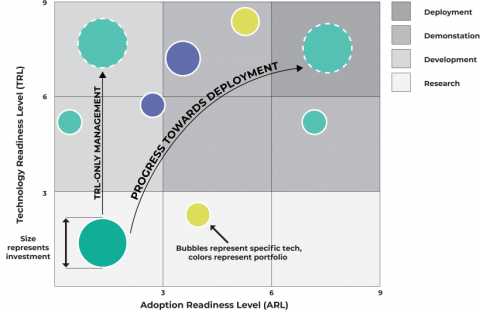Bringing novel technologies from the lab to the market requires moving through the Research, Development, Demonstration, and Deployment (RDD&D) continuum. To commercial-scale deployment, one must overcome both technical and ecosystem adoption hurdles. While this journey is complex, support exists. The Department of Energy’s Office of Technology Transitions is mission-driven to steward commercialization efforts across the Department and beyond.
The management of modern technology portfolios can be enhanced by complementing the widely used Technology Readiness Level (TRL) framework. Yet technical feasibility only tells half of the story when it comes to a product’s deployment at commercial scale. Other adoption considerations – such as product-market fit, demand pull, supply chain, regulatory risks, and workforce availability – all play roles in the likelihood of a technology’s successful deployment.
The Adoption Readiness Level (ARL) framework was developed by the U.S. Department of Energy’s Office of Technology Transitions in partnership with industry stakeholders, serve as a complement to the TRL framework. The ARL framework assesses 17 different adoption risks of a technology and translates the risk assessment into a 1 to 9 adoption readiness score.
LEARN MORE about A Framework to Drive Technology Commercialization>
Core Risk Areas Addressed by ARL
Determine your qualitative risk assessment across 17 dimensions of adoption risk spanning these four core risk areas.
Value Proposition
Assesses the ability for a new technology to meet the functionality required by the market at a price point that customers are willing to pay, to meet the market demand (a broadened definition of “product-market fit”).
Market Acceptance
Captures the target market(s) demand characteristics and risks posed by existing players — including competitors, customers, and other value chain players.
Resource Maturity
Determines risks standing in the way of inputs that are needed to produce the technology solution.
License to Operate
Identifies the societal (national, state, and local), non-economic risks that can hinder the deployment of a technology.
Download the ARL Assessment
Who Should Use ARL?
The ARL framework is used by all participants in the commercialization ecosystem: from technologists and entrepreneurs to technology incubators to financial institutions providing funding. DOE offices use ARL to inform program design, investment, and risk management decisions.
Today’s ARL users include:
| Technologists | Incubators | DOE Program Offices | National Labs | Universities and Academia |
| Project Managers | Investors | Insurance Industry | Researchers | Think Tanks |
We are actively developing and refining this framework by workshopping with industry and U.S. government stakeholders. Please provide your input by contacting ARL@hq.doe.gov.
Sandia National Lab, in partnership with the Office of Technology Transitions, conducted an ARL pilot program focused on emerging technologies in their ecosystem. The program helped technology teams reduce adoption risks, clarify commercialization roadmaps, and apply for funding more effectively. By using ARLs, the teams deepened their understanding of market needs and communicated their technologies’ value more clearly. This pilot established a repeatable process for evaluating adoption risks, contributing to faster commercial deployment.
The Geneva Association leveraged the ARL framework to drive innovation in the insurance sector by addressing climate tech risks. A new Insurability Readiness Framework (IRF) was developed, aligning insurance risk categories with ARL-based commercialization risks. This framework has improved risk management conversations between insurers and stakeholders and facilitated the development of insurance solutions for climate technologies like green hydrogen and CCUS.
BRITE Energy Innovators integrated the ARL framework into its BRITEelevate program to help startups assess market viability. The framework enabled companies, such as AnywherEnergy Systems, to align their co-founders on commercialization risks and develop strategic plans with clear, achievable milestones. ARLs provided a structured approach to understanding and addressing commercialization challenges, helping teams prepare for funding and customer engagement.
OCED applies the ARL framework to assess commercialization barriers in its investment areas. This allows OCED to design programs that target risk reduction and monitor the progress of their portfolio toward commercial liftoff. By categorizing and tracking risks, OCED can better support its projects and the broader market in overcoming commercialization challenges.






